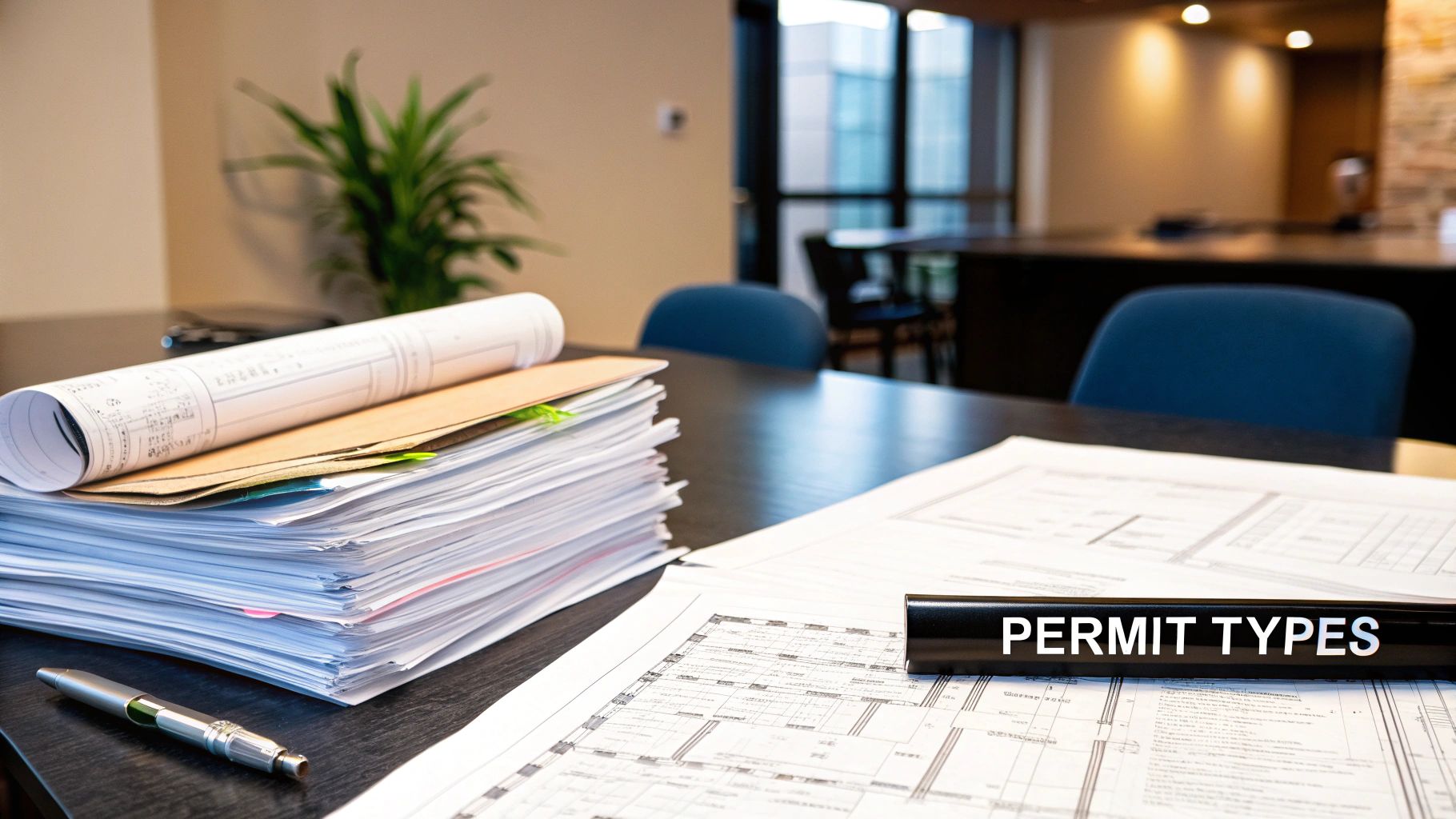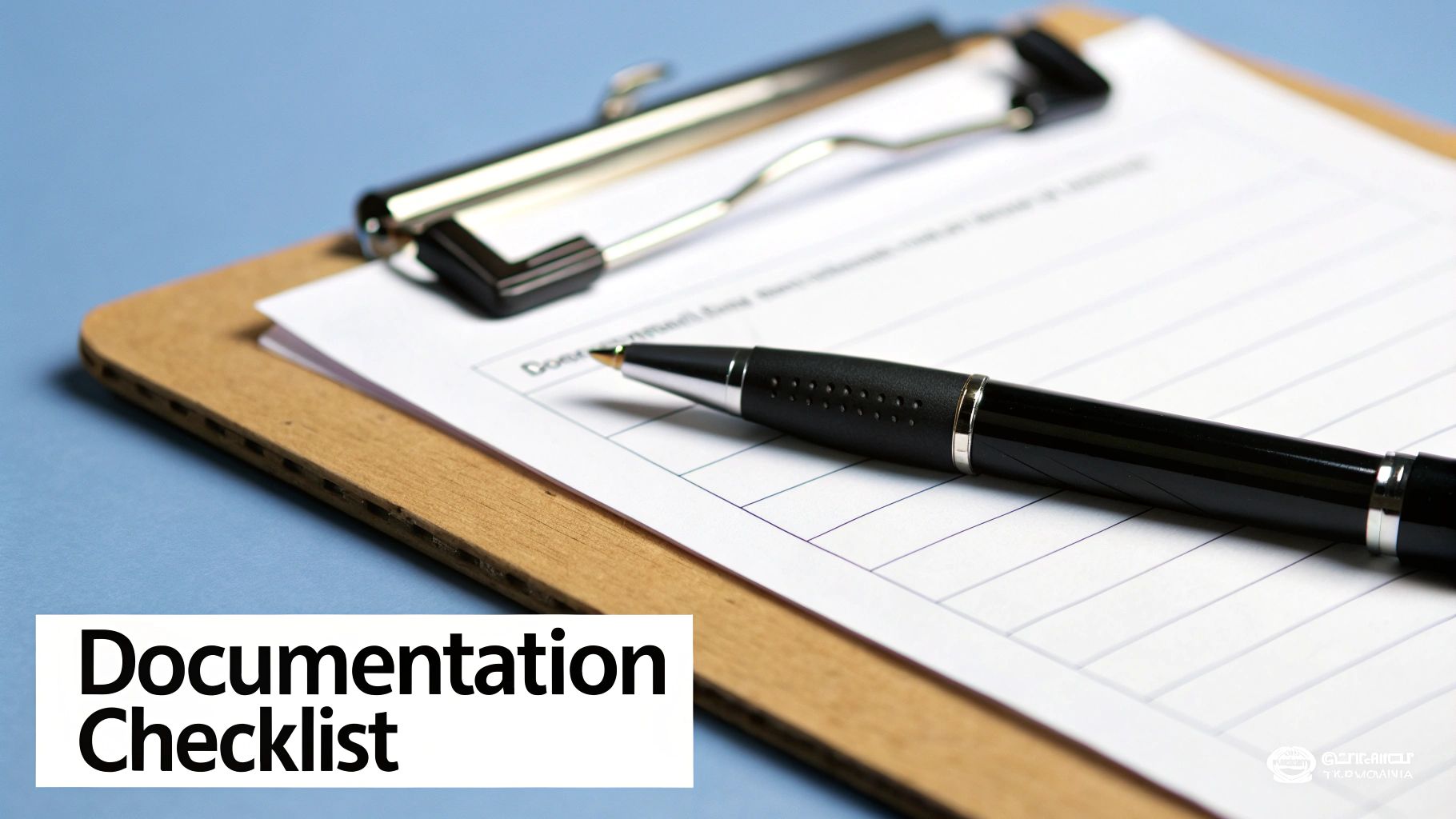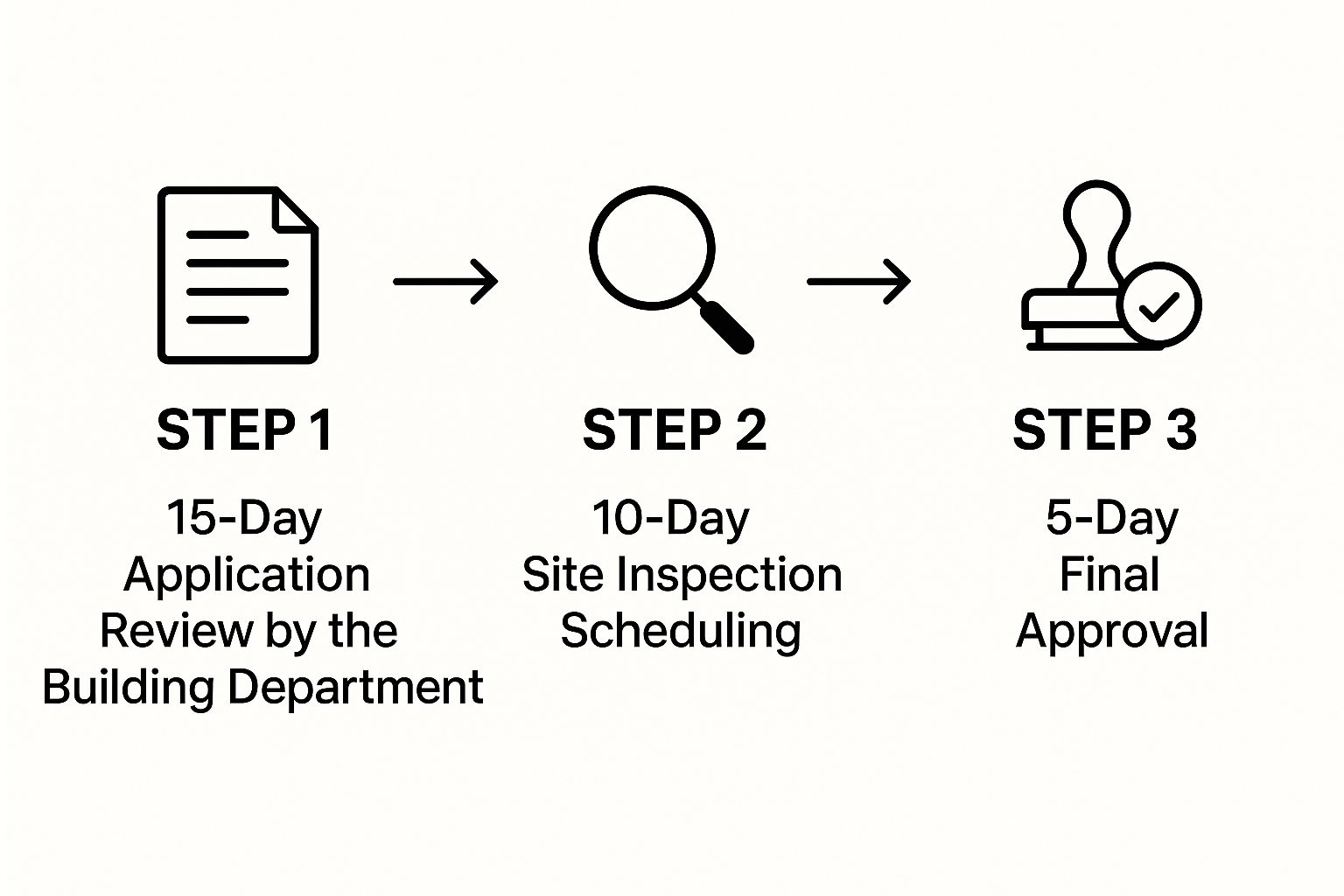The world of commercial building permits can feel like a maze of red tape, but getting through it is non-negotiable. These aren't just arbitrary rules; they are the specific documents, codes, and inspections you have to satisfy to legally build or even just renovate a commercial space.
Think of the permit process as a crucial quality check. It’s there to make sure your project is safe for everyone who will use it and that it complies with all local, state, and even national building standards.
What to Expect with Commercial Permits
Jumping into a commercial project without understanding the permitting process is a recipe for disaster. It’s the foundational roadmap that protects you, your investment, and the community. Ignoring it can lead to crippling fines, stop-work orders that grind your project to a halt, or, in a worst-case scenario, the demolition of anything built without approval.
Getting a handle on the permit journey from the start helps you set a realistic budget, timeline, and resource plan. Knowing what's ahead is half the battle won.
The Team You'll Need
Successfully navigating the commercial permit process is a team sport. You’ll be leaning heavily on a few key professionals who know the ins and outs of the system.
- Architects and Engineers: These are the experts who turn your big idea into detailed, code-compliant blueprints. Their work is the backbone of your application, and a good set of plans makes life much easier for the people who have to review it.
- City Planners and Examiners: These are the gatekeepers. They're the local officials who will comb through your submission, checking everything from zoning laws to fire safety codes to make sure it all lines up with legal requirements.
- Contractors: Your general contractor is the one on the ground, making it all happen. They're responsible for making sure the physical construction perfectly matches the plans that got approved and that the project passes every single inspection along the way.
How Long Does This Really Take?
Here's where a lot of people get tripped up: the timeline. It’s almost always longer than you think. Getting a permit isn't a simple transaction where you just drop off some forms and walk out with an approval stamp.
One of the biggest mistakes I see is people assuming they can get a permit in a couple of weeks. For a standard commercial project, you should budget anywhere from 30 to 90 days just for the plan review—and that’s if your submission is flawless on the first try.
The timeline is also at the mercy of factors you can't control, like how busy your local building department is. When construction is booming, expect a backlog. You can get a sense of these trends by looking at economic data; the number of permits being issued is a major indicator of construction activity. When interest rates are low and building is hot, those review times stretch out. For more on this, Trading Economics offers some great insights into how the broader economy impacts permit trends.
Your Pre-Application Groundwork
Before a single application form is filled out, the most important work on your project has to happen. I've seen countless commercial projects get bogged down in delays and rejections, and it almost always traces back to a failure to lay the proper groundwork. Getting these foundational pieces right from the very beginning is your best shot at a smooth and predictable review process.

First things first: zoning verification. You have to be absolutely sure your project's intended use is permitted on that specific piece of land. It sounds obvious, but you’d be surprised. You can't just decide to build a retail shop in an area zoned strictly for residential use, for example. A quick check on your local planning department’s website can save you from a catastrophic mistake before you’ve spent a penny on design work.
Assembling Your Professional Team Early
One of the smartest things you can do is get your professional team involved from day one. Don't wait until you hit a snag. Having an architect, a structural engineer, and a general contractor at the table early on means compliance is designed into the project, not patched on later as a costly afterthought.
These pros live and breathe the local commercial building permit requirements. They know the codes, they know the reviewers, and they can spot potential red flags a mile away. When they work together from the start, you ensure the architectural plans, structural calculations, and construction methods are all aligned and code-compliant from the get-go. This is how you avoid those painful and expensive plan revisions down the line.
Gathering Essential Documentation
Once your team is in place, it's time to start gathering your preliminary documents. This goes way beyond just the blueprints. You need to prove you have the legal and logistical standing to even start the project.
Your initial document package will almost always need to include:
- Proof of Ownership: A deed or title report showing you have the legal authority to build on the property.
- Detailed Site Survey: This isn't just a sketch. You need a formal survey from a licensed surveyor that details property lines, easements, topography, and any existing structures.
- Preliminary Environmental Reports: Depending on your site's history, you might need to show reports on things like soil contamination, protected wetlands, or even endangered species habitats.
Walking into the permitting office with these documents organized and ready shows the plan reviewer you’re a professional who has done their homework. It builds immediate credibility.
A disorganized or incomplete pre-application package is a major red flag for city reviewers. It signals that the project may be poorly planned, which almost guarantees a more difficult and lengthy review cycle.
Think of this pre-application phase as proactive risk management. By confirming zoning, building a solid team, and organizing your core documents, you're knocking out the biggest reasons for initial rejection before they can become a problem. It’s a bit of time invested upfront that pays for itself ten times over in saved money and headaches.
Assembling a Winning Permit Application Package
If there's one secret to getting your commercial building permit approved without major headaches, it's this: prepare an application package that’s impossible to poke holes in. Don't think of it as just paperwork. Think of it as telling the complete story of your project through clear, detailed, and undeniable documentation. A well-organized submission screams professionalism and makes the plan reviewer's job easier, which can only help your case.

The heart and soul of your application are the plans and drawings. These aren't just concept sketches; they are the technical blueprints that prove your project is safe, functional, and ticks every box of the commercial building permit requirements.
The Essential Blueprints and Schematics
You'll need to submit several distinct sets of plans, and each one must be stamped by the appropriate licensed professional. Don't underestimate the level of scrutiny these documents will face—reviewers are paid to find any deviation from structural, safety, and accessibility codes.
- Architectural Drawings: These are your master plans. They lay out the entire project, including floor plans, elevations, sections, and site plans. This is where you show the building’s layout, materials, dimensions, and how it sits on the property.
- Structural Plans: An engineer has to prepare these. They detail the building's skeleton—everything from the foundation and framing to the beams, columns, and load-bearing walls. This is your proof that the structure can hold itself up and handle whatever the environment throws at it.
- MEP Schematics: Mechanical, Electrical, and Plumbing plans are non-negotiable. These schematics outline HVAC systems, all electrical wiring and fixtures, and the complete plumbing and drainage infrastructure.
A classic rookie mistake is providing plans that lack critical detail. For instance, just labeling a room "Restroom" won't fly. The reviewer needs to see the exact fixture locations, proof of ADA-compliant clearances, and all the specs for the plumbing and ventilation. Leave nothing to the imagination.
Supporting Documents That Build Your Case
Beyond the core blueprints, you’ll need a stack of supporting documents to provide context and prove compliance. Forgetting even one of these can trigger an instant rejection or a request for information (RFI), which can stall your project for weeks, if not months.
Here’s where we get into the nitty-gritty. This is the evidence that your project adheres to specific regulations. For example, most jurisdictions require energy code compliance forms (like COMcheck) to prove your building's insulation, windows, and mechanical systems meet modern efficiency standards. You might also need a geotechnical report to verify the soil can actually support the foundation you’ve designed.
This is where organization is your best friend. I've created a table to summarize the key documents you'll almost certainly need.
Core Documents for Your Commercial Permit Application
| Document Type | Primary Purpose | Key Details to Include |
|---|---|---|
| Architectural Drawings | Defines the building's layout, appearance, and use. | Floor plans, elevations, sections, site plan, material specifications, ADA compliance details. |
| Structural Plans | Proves the building's structural integrity and safety. | Foundation design, framing plans, load calculations, connection details, material strengths. |
| MEP Schematics | Outlines all mechanical, electrical, and plumbing systems. | HVAC system layouts, electrical panel schedules, lighting plans, plumbing isometrics, fire sprinkler design. |
| Energy Code Forms | Demonstrates compliance with energy efficiency standards. | Insulation R-values, window U-factors, HVAC efficiency ratings, lighting power density calculations. |
| Geotechnical Report | Assesses soil conditions and foundation requirements. | Soil boring logs, bearing capacity, recommendations for foundation type and site preparation. |
| Special Inspection Forms | Identifies required third-party inspections. | Lists for concrete, steel welding, high-strength bolting, fireproofing, and other critical elements. |
Think of this table as your checklist. Having every one of these documents prepared and in order before you submit will put you miles ahead of the game.
A well-organized application with a clear table of contents is a small effort that pays huge dividends. It helps the reviewer navigate your submission efficiently and shows that you respect their time, setting a positive tone for the entire review process.
The level of detail required can change dramatically depending on where you're building. Globally, commercial construction is a tale of two worlds. Between 2022 and 2023, floorspace grew by about 5 billion square meters, but over half of that new construction in developing economies had no building energy codes enforced. That’s a stark contrast to markets like the U.S. and Germany, where rigorous standards are the norm. You can dive deeper into these global construction trends in the Global Status Report.
Bottom line: every single document you submit needs to be crystal clear, perfectly accurate, and easy for the reviewer to find. This meticulous attention to detail is what separates an application that sails through from one that gets lost in bureaucratic limbo.
Making Sense of Building Codes and Compliance
Navigating building codes is the technical core of getting your commercial building permit. These aren't just arbitrary rules—they are legally enforceable standards built around a single, critical mission: protecting public health, safety, and welfare. I've found it's helpful to think of them less as bureaucratic red tape and more as the safety blueprint for your entire project, influencing everything from how the structure stands up to how people get out in a fire.

The main standard you’ll be working with is the International Building Code (IBC), which sets a comprehensive safety baseline. But here’s the catch: it’s almost never that simple. Most states, counties, and cities adopt their own modified version of the IBC. They'll add amendments to address local concerns, like enhanced requirements for hurricane-resistant construction in Florida or specific seismic designs in California. It's on you and your design team to pinpoint and adhere to the exact code your jurisdiction has on the books.
Understanding Key Code Categories
The full codebook can be incredibly dense. After years in the field, I’ve learned to mentally sort the rules into a few key buckets. Focusing on these areas from the start helps you design for compliance, not just aesthetics.
- Structural Integrity: This is all about the building's skeleton. It covers the physics of how your structure will handle everything from its own weight to external forces like wind, snow, and earthquakes. Your structural engineer’s plans have to prove every single beam and column can handle the load.
- Fire and Life Safety: This is a massive part of any plan review. It governs requirements for fire-rated walls, sprinkler systems, smoke alarms, and—most importantly—clear, unobstructed exit paths for everyone inside.
- Accessibility (ADA): The Americans with Disabilities Act isn't a building code in the traditional sense; it's a federal civil rights law. Compliance is non-negotiable. Your design must provide equal access for people with disabilities, dictating everything from ramp slopes and doorway widths to the specific layout of restrooms.
- Energy Efficiency: Modern codes are also focused on sustainability. They mandate minimum levels of insulation, window performance (U-factor), and HVAC system efficiency. The goal is to reduce the building's energy footprint over its entire life.
Overlooking any of these can bring your project to a screeching halt. A classic mistake I see all the time is designing a beautiful entryway that fails to provide the minimum 36-inch clear width needed for wheelchair access. It’s a small detail that can force an expensive and time-consuming redesign.
Codes in Real-World Scenarios
The best way to get a feel for compliance is to see how the rules play out on an actual project. Let’s walk through a common scenario: converting a ground-floor retail space into a new restaurant.
The very first thing a plan reviewer will do is determine the occupancy classification. A restaurant is typically an "Assembly" use, which carries much stricter requirements than the previous "Business" or "Mercantile" use of a retail shop.
A change in occupancy classification is one of the biggest triggers for a deep-dive code review. Even if you aren't moving a single wall, simply changing how the space is used can force major upgrades to fire suppression, ventilation, and exit systems to match the new risk level.
This classification change immediately impacts your occupant load calculation. The code uses the square footage of your dining area to determine the maximum number of people allowed inside at one time. That single number is a linchpin that dictates several other critical design elements:
- The Number of Exits: A higher occupant load means you need more ways for people to get out in an emergency.
- Restroom Fixture Counts: The code has specific formulas for the minimum number of toilets and sinks based on that maximum occupancy.
- Ventilation Requirements: Commercial kitchens and crowded dining rooms have robust HVAC requirements to maintain proper air quality.
For our restaurant example, if the proposed dining area is 1,500 square feet, the IBC might calculate an occupant load of 100 people (based on a factor of 15 square feet per person for that use). That calculation instantly tells the plan reviewer that you will need at least two separate and remote exits and a certain number of fully accessible restrooms. Building this logic into your initial design from day one is far smarter—and cheaper—than having a plan reviewer flag it for you weeks later.
Surviving the Permit Review and Inspection Process
You’ve spent weeks, maybe months, getting your application package just right. Hitting that submit button feels like a huge win, but in reality, you’ve just entered the next phase of the waiting game. This is where your meticulously crafted plans go under the microscope of city examiners, a process that can seriously test your patience.
Once your application is in the system, it enters the plan review queue. Think of this less as a single step and more as a multi-departmental relay race. Your plans are going to be passed between several departments, and each one is looking for something different.
- Zoning Department: They're double-checking that your project's proposed use, height, and setbacks still play by the local land-use rules.
- Public Works: This team is focused on how your project impacts public infrastructure. They'll scrutinize everything from sewer and water connections to stormwater management.
- Fire Department: For them, it's all about life safety. They'll pour over your fire sprinkler designs, emergency exit plans, and accessibility routes.
It’s almost a given that you’ll get a Request for Information (RFI) or a list of comments from an examiner at some point. Don't freak out—this is a normal part of the process. The trick is to respond quickly and thoroughly. Address every single comment directly, provide exactly what they're asking for, and get those revised plans resubmitted fast. If you don't, your project can easily get pushed to the bottom of their massive pile.
From Plan Review to On-Site Inspections
Getting your permit stamped and approved is a major milestone, but the city's oversight is far from over. Now, the scrutiny moves from paper plans to the physical job site. You'll have to schedule a series of mandatory on-site inspections at key construction stages to prove the work is being done exactly as specified.
I see this all the time: a contractor schedules an inspection before the work is truly ready. If that phase isn't 100% complete—for instance, if not every pipe is in place for the rough-in plumbing inspection—you're guaranteed to fail. That means costly re-inspection fees and frustrating delays.
These inspections follow a strict sequence; you can't get your framing signed off until the foundation has passed. The major checkpoints usually include the foundation, framing, MEP (Mechanical, Electrical, and Plumbing) rough-in, and of course, the final inspection required to get your Certificate of Occupancy.
This graphic breaks down what a typical timeline can look like for the review and inspection stages.

As you can see, even in a best-case scenario, the journey from submitting your plans to final approval can easily take several weeks.
It's also smart to remember that bigger economic forces are at play. According to recent data from Canada, the total value of building permits issued in April 2025 dropped by 6.6% in one month, down to $11.7 billion. A slowdown like that, often concentrated in specific regions, can ripple through the industry, affecting everything from material costs to how long your plans sit in the review queue. You can see more about how economic factors impact construction permit trends from Statistics Canada.
Common Questions I Get About Commercial Building Permits
Navigating the commercial permit process is a minefield of details, and it's easy to get tripped up. Even project managers with years under their belts run into snags. To help you sidestep some of the most common pitfalls, let's walk through the questions I hear all the time from business owners and developers.
How Long Does It Take to Get a Commercial Building Permit?
This is the big one, and the honest answer is always, "it depends." I've seen permits for small interior renovations sail through in as little as four to six weeks when the application was perfect. But for new commercial construction? You need to brace yourself for a much longer haul—think three to six months, and sometimes even longer.
So, what causes such a huge variation? A few key things:
- Application Completeness: This is the number one project killer. A single missing document or an inaccurate form can send you right back to the starting line.
- Project Complexity: A simple tenant fit-out for a retail space is in a completely different league than a multi-story new build with complex structural engineering. More complexity means more scrutiny.
- Jurisdiction Workload: If your local building department is buried under a mountain of applications from a recent development boom, your plans will simply have to wait their turn.
What Are the Most Common Reasons for Permit Rejection?
Outright rejections are rare. What's far more common is getting your plans kicked back with a long list of corrections. After seeing hundreds of these review comments, a few familiar offenders always top the list.
The biggest culprit is incomplete or incorrect architectural drawings. I'm talking about missing details, conflicting information between different plan sheets, or designs that are just flat-out non-compliant with local zoning. Another huge one is failing to nail the accessibility standards. A miscalculation on a ramp slope or a few inches off on restroom clearances will get your plans flagged instantly.
Your permit application isn't a list of suggestions; it's a technical legal document. The plan reviewers are trained professionals whose entire job is to find discrepancies. Trying to sneak a known code violation past them is the fastest way to get your project stalled and add weeks of expensive revisions to your timeline.
Do I Need a Permit for Interior Commercial Renovations?
I get this one a lot. The answer is almost always a resounding "yes." People are often surprised by how low the threshold is for requiring a permit. Sure, you probably don't need one to slap on a new coat of paint or replace the carpet. But the second you touch anything structural, electrical, or plumbing-related, you're in permit territory.
This covers a lot of common renovation work, including:
- Moving or adding interior walls (even if they aren't load-bearing)
- Altering electrical circuits or adding new outlets
- Changing the plumbing layout in a breakroom or restroom
- Modifying the HVAC system
Even work that seems minor on the surface can have a major impact on things like fire safety and emergency egress. When in doubt, make the call to your local building department before you start swinging a hammer.
How Much Do Commercial Building Permits Typically Cost?
Permit fees are another moving target, tied directly to the total value of your construction project. Most cities and counties use a sliding scale, so the fee is calculated as a percentage of the project's cost. For a small interior job, you might only be looking at a few hundred dollars. But for a major new build valued at $1 million, it wouldn't be unusual for the permit fees alone to run between $10,000 and $20,000.
Remember, that main fee is just for the plan review and the necessary on-site inspections. Don't forget to budget for other potential costs that can sneak up on you, like impact fees for connecting to new utilities, which can easily add thousands more to your final bill.
Are construction delays from a missing natural gas line putting your project on hold? Blue Gas Express provides temporary CNG and LNG solutions to keep your job site powered and on schedule. You can meet occupancy requirements and keep your site heated without interruption. Find out more about their temporary natural gas services.